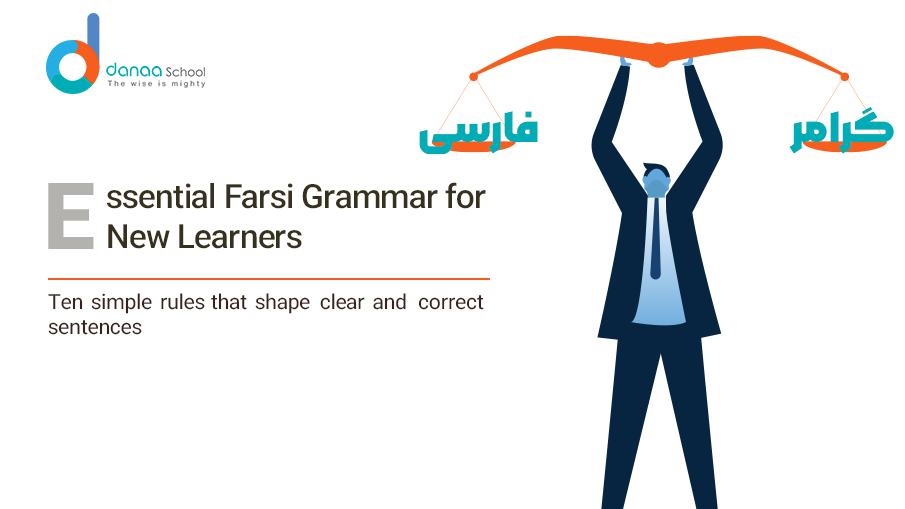10 Farsi Grammar Rules Every Beginner Should Know
Learning Farsi (Persian) opens doors to a rich culture, poetry, and deep conversations with native speakers. But before you dive into Farsi vocabulary and common phrases, understanding the basic grammar rules will make your learning journey much smoother.
Whether you plan to introduce yourself in Farsi, build simple sentences, or expand your vocabulary, mastering these essential grammar rules will set you on the right path.
10 Farsi Grammar Rules
1. No Articles in Farsi
Unlike English, Farsi does not have definite (“the”) or indefinite (“a, an”) articles. Instead, context determines whether a noun is specific or general.
- Example:
- “کتاب” (ketâb) – “Book” (It could mean “a book” or “the book” depending on the context.)
2. Subject-Object-Verb Sentence Structure
Farsi follows a Subject-Object-Verb (SOV) structure, meaning the verb usually comes at the end of the sentence.
- Example:
- English: I read a book.
- Farsi: من کتاب میخوانم. (Man ketâb mikhânam.) – Literally: I book read.
This can initially feel unnatural to English speakers, but with practice, it becomes easier.
3. Verb Conjugation Changes with Subject
Farsi verbs change according to the subject, similar to other languages like Spanish or French. The verb root remains the same, but different endings attach to match the subject pronoun.
- Example (Present Tense of “To Go” – رفتن / raftan):
- من میروم. (Man miravam.) – I go.
- تو میروی. (To miravi.) – You go.
- او میرود. (Oo miravad.) – He/She goes.
Understanding verb conjugation is key to forming correct sentences.
4. No Gendered Nouns
Unlike Spanish or German, Farsi does not assign gender to nouns. The word “teacher” (معلم / mo’allem), for instance, can refer to a male or female teacher without changing the word. This makes learning Farsi grammar easier compared to gendered languages.
5. Possessive Pronouns Attach to Nouns
In Farsi, possessive pronouns (my, your, his, etc.) attach to the noun instead of standing separately.
- Example:
- کتاب من (ketâb-e man) – My book
- کتاب تو (ketâb-e to) – Your book
- کتاب او (ketâb-e oo) – His/Her book
This structure is simple once you get used to it!
6. Adjectives Come After Nouns
In Farsi, adjectives follow the noun they describe, unlike in English where adjectives come before the noun.
- Example:
- English: A beautiful city
- Farsi: شهر زیبا (shahr-e zibâ) – Literally: city beautiful
This is an important rule to remember when forming descriptive sentences.
7. Negation Uses “ن” (Na) or “نمی” (Nemi)
To make a verb negative in the present tense, add “نمی” (nemi) before it. For past tense, use “ن” (na).
- Examples:
- من نمیدانم. (Man nemidânam.) – I don’t know.
- او نیامد. (Oo nayâmad.) – He/She didn’t come.
Understanding negation will help you form accurate sentences in Farsi.
8. Pluralization Often Uses “ها” (Hâ)
In Farsi, most plural nouns take the suffix “ها” (hâ), though some words follow irregular plural forms.
- Example:
- کتابها (ketâbhâ) – Books
- خانهها (khânehâ) – Houses
Certain words of Arabic origin use different plural endings, but beginners should focus on “ها” (hâ) first.
9. Time Expressions and Verb Tenses
Farsi has simple present, past, and future tenses, but context often determines time. Unlike English, Farsi doesn’t always require auxiliary verbs for the future tense.
- Examples:
- فردا میروم. (Fardâ miravam.) – I will go tomorrow.
- دیروز رفتم. (Dirooz raftam.) – I went yesterday.
Telling time in Farsi is straightforward once you grasp common time words.
10. Questions Start With Statements
To form a question in Farsi, you usually keep the sentence structure the same but add question words like:
- چی؟ (Chi?) – What?
- کجا؟ (Kojâ?) – Where?
- کی؟ (Key?) – When?
- Example:
- شما از کجا هستید؟ (Shomâ az kojâ hastid?) – Where are you from?
- او چه کار میکند؟ (Oo che kâr mikonad?) – What does he/she do?
No need to rearrange words like in English – just add a question word!
Persian Language Phrases for Beginners
Here are some must-know Persian phrases to start speaking Farsi today:
- سلام (Salâm) – Hello
- خداحافظ (Khodâhâfez) – Goodbye
- بله / نه (Bale / Na) – Yes / No
- متشکرم (Motashakkeram) – Thank you
- خواهش میکنم (Khâhesh mikonam) – You’re welcome
How to Introduce Yourself in Farsi
Introducing yourself is one of the first steps in learning any language. Here’s a simple way to do it in Farsi:
👤 My name is Amir.
من امیر هستم. (Man Amir hastam.)
📍 I am from Canada.
من اهل کانادا هستم. (Man ahl-e Kânâdâ hastam.)
🗣 I am learning Persian.
من فارسی یاد میگیرم. (Man Fârsi yâd migiram.)
Practice these phrases to introduce yourself confidently!
Essential Farsi Vocabulary for Beginners
To build your Farsi skills, start with these essential words:
- خانه (Khâneh) – House
- مدرسه (Madreseh) – School
- ماشین (Mâshin) – Car
- کتاب (Ketâb) – Book
- دوست (Doost) – Friend
Start Learning Farsi with Danaa School!
Ready to improve your Farsi skills? Join Danaa School, where expert teachers guide you through Farsi grammar, vocabulary, and conversation practice. Start today and connect with Persian speakers worldwide!
👉 Learn Farsi Now!
FAQs
- Is Farsi grammar challenging to learn?
Farsi grammar is relatively simple compared to many languages, especially because it has no gendered nouns and follows consistent rules. - How long does it take to learn basic Farsi?
You can learn basic conversational Farsi in 3-6 months with regular practice. - Is Farsi written from right to left?
Yes, Farsi uses the Persian script and is written from right to left. - What’s the best way to practice Farsi?
Speaking with native speakers, listening to Persian music, and taking online lessons with Danaa School are great ways to practice. - Can I learn Farsi without learning the script?
Yes, but learning the Persian script will help you understand Farsi better and improve your pronunciation. - Are Farsi and Arabic similar?
While Farsi uses many Arabic loanwords, it is an entirely different language with its own grammar and vocabulary. - Is Farsi spoken outside of Iran?
Yes! Farsi is spoken in Afghanistan (as Dari) and Tajikistan (as Tajik).









